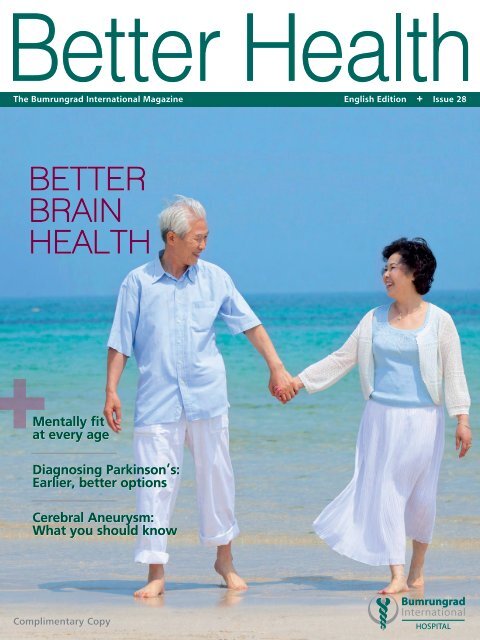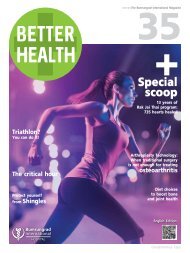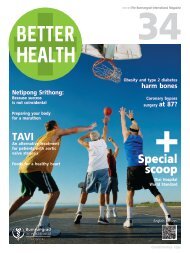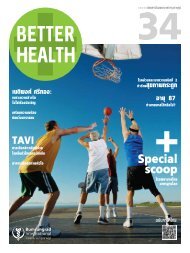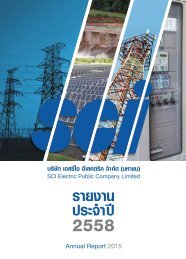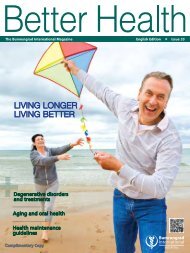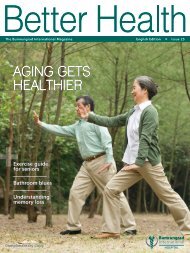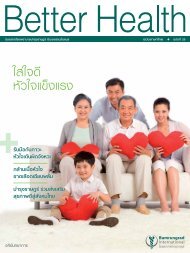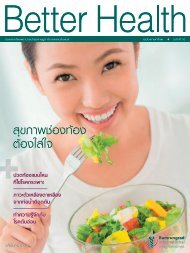Better Health 28 ENG
The magazine for patients and friends of Bumrungrad International Hospital, Thailand.
The magazine for patients and friends of Bumrungrad International Hospital, Thailand.
Create successful ePaper yourself
Turn your PDF publications into a flip-book with our unique Google optimized e-Paper software.
W e l c o m e<br />
Welcome to<br />
, the magazine <br />
for patients and friends of Bumrungrad <br />
International Hospital.<br />
The brain is the body’s most important and<br />
omplex organ. It is responsible for every aspect <br />
and activity of everyday living. This issue of <br />
focuses special attention on the most<br />
serious threats to brain health. <br />
Brain disorders including dementia, Alzheimer’s<br />
disease, Parkinson’s disease and stroke cause <br />
tremendous loss of life and permanent disability. <br />
Becoming aware of one’s personal risk factors, <br />
and understanding the importance of earlier <br />
diagnosis and treatment, can help prevent brain <br />
disorders and reduce their severity if they occur. <br />
Beginning on page 4, our feature on dementia <br />
and Alzheimer’s updates readers on progress in <br />
diagnosing and treating these serious disorders, <br />
and offers expert advice for caregivers and loved <br />
ones providing critical support to patients. <br />
Stroke is among the world’s leading causes of <br />
death. Hemorrhagic stroke, also called cerebral <br />
aneurysm, is the type of stroke that causes bleeding<br />
in the brain. Our feature on page 8 briefs readers<br />
on what they should know to prevent them, and <br />
what to do if a stroke occurs. <br />
On page 22, we focus on Parkinson’s disease <br />
and recent progress in treating the widespread <br />
condition, and how the right kind of care is giving<br />
a major boost to patients’ quality of life.<br />
As always, we welcome your feedback, ideas <br />
and comments about<br />
. Please feel <br />
free to e-mail us at betterhealth@bumrungrad.com.<br />
We look forward to hearing from you, and here’s <br />
wishing you better health.<br />
<br />
<br />
<br />
<br />
Dr. Jitra Anuras<br />
Senior-Associate <br />
Medical Director<br />
C o n t e n t s<br />
4 Dementia & Alzheimer’s <br />
Helping patients and caregivers<br />
8 Cerebral Aneurysm<br />
What you should know about<br />
hemorrhagic stroke<br />
12 Q&A<br />
14 Epilepsy<br />
Helping parents & kids tackle <br />
the challenges of epilepsy<br />
18 <strong>Health</strong> Briefs<br />
20 M.D. Focus<br />
Get to know our doctors<br />
22 Parkinson’s Disease<br />
The case for earlier detection<br />
26 News from Bumrungrad International<br />
4 14 22<br />
<strong>Better</strong> <strong>Health</strong> magazine is published by Bumrungrad Hospital Public Company Limited and is produced <br />
for Bumrungrad Hospital Public Company Limited by Oakins and Stone Limited, 16 Asoke Court,<br />
Suite 2-A, Sukhumvit 21 Road (Asoke), Klongtoey-nua, Wattana, Bangkok 10110. Tel: +66 (0) 2261 1211<br />
Fax: +66 (0) 2261 1213. www.oakinsandstone.com<br />
No part of this magazine may be reproduced without the written permission of Bumrungrad Hospital <br />
Public Company Limited. 2013 by Bumrungrad Hospital Public Company Limited. All rights reserved. <br />
Publication of advertisements or sponsorships shall not constitute an endorsement by Bumrungrad <br />
Hospital Public Company Limited of the products or services promoted, of the company or organization,<br />
nor of the claims made.<br />
Telephone:<br />
Facsimile:<br />
Out-patient<br />
appointment:<br />
Website:<br />
66 (0) 2667 1000<br />
66 (0) 2667 2525<br />
66 (0) 2667 1555<br />
www.bumrungrad.com
BONE MYTHS & TRUTHS<br />
Busting the myths<br />
about bones and joints<br />
Many widely-held beliefs about bone and joint <br />
health turn out to be falsehoods or half-truths. <br />
Here’s a look at some of the popular myths, <br />
and the facts that prove them wrong.<br />
We live in an age of free-flowing information that <br />
comes at the click of a mouse. That’s a good thing <br />
for the most part, but it sometimes adds to the <br />
challenge of separating the truth from everything else. <br />
A look at the facts will demonstrate that some of the <br />
most widely-believed myths simply aren’t true. <br />
<br />
A bone fracture is less serious<br />
than a broken bone <br />
Many people believe that a bone fracture is a less <br />
serious event than a broken bone. In reality, the <br />
two are identical. Severe fractures can result in a <br />
bone breaking up into two or more separate pieces. Minor <br />
fractures involve a crack in a bone that remains intact, <br />
sometimes called a hairline fracture.<br />
The types and degrees of fractures are numerous, but<br />
each and every one involves a bone that has been broken<br />
and should be examined by a doctor to assess the damage<br />
and repair the break. <br />
<br />
After bones are fully developed,<br />
they don’t change<br />
The model skeletons that helped us learn as kids <br />
never changed, but for real fully-grown adults, <br />
bones have the capacity to change throughout <br />
our lives. Their ever-changing nature can be attributed to <br />
osteoblasts, the cells responsible for generating bone mass. <br />
Osteoblasts react when bones come under stress. They <br />
help boost bone strength to counter the stress, especially <br />
in and around the joints where the stress is concentrated. <br />
Weight-bearing exercise such as moderate jogging is an <br />
effective way to help stimulate bone production. This helps <br />
lower the risk of osteoporosis and promotes faster recovery<br />
for patients with osteoporosis-related problems.<br />
<br />
Osteoporosis is a painful<br />
bone condition<br />
Osteoporosis is a disease that causes loss of <br />
bone mass. But unless a bone has fractured, <br />
osteoporosis doesn’t cause pain. <br />
Osteoporosis can go undetected for years. Without causing<br />
any noticeable symptoms, it gradually eats away at bones. <br />
Detecting osteoporosis is done using a bone densitometry <br />
scan – a test advised for adults beginning at age 40. The <br />
scan is an important element in osteoporosis prevention <br />
and earlier detection. <br />
<br />
Arthritis is a disease for old people<br />
While our arthritis risk increases as we age, <br />
seniors don’t have a monopoly on the disease.<br />
This painful joint condition can strike children,<br />
teenagers and adults of all ages. <br />
It’s true that arthritis can result from the gradual deter-<br />
ioration of joints after years of over-use and wear-and-tear.<br />
But arthritis has many types and multiple causes –<br />
rheumatoid arthritis, gout, psoriatic arthritis, accidents,<br />
infections, etc. – none of which discriminate based on age.<br />
<br />
People with arthritis have<br />
to stop doing . . .<br />
Arthritis patients can encounter challenges<br />
carrying on some of their normal activities, but<br />
treating them as helpless or powerless is not<br />
the answer. <br />
The best way to care for someone with arthritis is give <br />
attentive care. Avoid being over-protective so as not to <br />
encourage the patient becoming too<br />
dependent – a situation that<br />
can affect the physical<br />
and mental well-<br />
being of patients<br />
and caretakers<br />
alike.
CEREBRAL ANEURYSM<br />
Cerebral Aneurysm: What you should<br />
know about hemorrhagic stroke<br />
Each year, cerebral aneurysms cause death and permanent damage to <br />
millions around the world. Here’s what you should know about the<br />
causes of hemorrhagic stroke, and what to do when a stroke occurs.<br />
It’s difficult to overstate the magnitude of the global threat:<br />
According to the World Stroke Organization (WSO), <br />
nearly 15 million people worldwide suffered a stroke <br />
last year, and half of them didn’t survive. Stroke and other <br />
types of cerebrovascular disease continue to rank at or near<br />
the top of the world’s leading causes of death and disability.<br />
Most people have a basic understanding of strokes,<br />
and many have lost loved ones to stroke. Fortunately,<br />
significant progress has been made in stroke diagnosis,<br />
treatment and prevention; patients now have a better<br />
chance of surviving a stroke, and there are better <br />
ways to limits its damaging effects.<br />
Unlike the more common ischemic stroke, which <br />
involves a clot or blockage, hemorrhagic stroke – also<br />
called cerebral aneurysm or brain aneurysm – results<br />
from the dilation or thinning of the wall of an artery <br />
or blood vessel in the brain that eventually tears or <br />
ruptures, allowing blood to flow into the brain. <br />
<br />
The nature of the threat <br />
Cerebral aneurysms are caused by an abnormal <br />
thinning of the wall of a blood vessel or artery carrying<br />
blood to the brain. The normal flow of blood through<br />
the body’s circulatory system exerts constant pressure<br />
on blood vessels – even more so when the patient <br />
has high blood pressure or hypertension. A blood <br />
vessel already weakened by thinning of its wall is<br />
at risk of developing a <br />
balloon-like bulge susceptible <br />
to tearing or rupturing,<br />
an event that can cause<br />
severe brain damage<br />
or even death. <br />
<br />
“We can try to identity a probable cause for a cerebral <br />
aneurysm, but it’s difficult to know precisely why some <br />
areas of the arterial wall are thinner than others,” explains<br />
Dr. Somkiet Siriwimonmas, a neuroradiologist at Bumrungrad.<br />
“It can be due to a congenital abnormality or the consequence<br />
of another disease. While Thailand doesn’t compile statistics<br />
on cerebral aneurysm, it is estimated that the condition is <br />
present in about two percent of the population.”<br />
According to Dr. Somkiet, there are a number of aspects<br />
“ It’s impossible to <br />
determine when the <br />
aneurysm might rupture;<br />
there won’t be any <br />
symptoms to alert the <br />
patient of the potential <br />
threat.”<br />
Dr. Somkiet Siriwimonmas<br />
that add to the medical challenges of dealing with cerebral <br />
aneurysm: It’s impossible to determine when the aneurysm<br />
might rupture; most patients don’t know that they have an <br />
aneurysm; and so long as the blood vessel or artery doesn’t<br />
rupture, there won’t be any symptoms to alert the patient <br />
of the potential threat. <br />
<br />
Accidental detection<br />
Detecting the presence of an aneurysm is often a case of <br />
coincidence or chance. “Detection tends to occur in one of<br />
three scenarios,” notes Dr. Somkiet. “The aneurysm may be<br />
spotted by coincidence when a patient undergoes a CT scan<br />
or MRI while being diagnosed for an unrelated condition; <br />
sometimes it’s found after a patient experiences symptoms <br />
resulting from the aneurysm causing compression of certain<br />
areas of the brain; or it is discovered when the patient has <br />
been admitted after suffering an actual stroke.”<br />
The threat of cerebral aneurysm can feel especially <br />
ominous due to the reality that it cannot be prevented.<br />
Dr. Somkiet points out that while the danger has been <br />
described as a time bomb ticking away inside the
p9 Ad La Roche
“ If ever you get a <br />
headache unlike any <br />
you’ve had before,<br />
get to a doctor <br />
immediately.”<br />
Dr. Roekchai Tulyapronchote<br />
head, “there’s no widely-used screening test to detect the <br />
condition, and the methods that are capable of aneurysm <br />
detection require expensive equipment, making their <br />
widespread use impractical. Even with advanced testing, <br />
it’s not possible to predict if or when an aneurysm will <br />
eventually rupture,” Dr. Somkiet adds. “Not all aneurysms <br />
end up causing strokes.” <br />
<br />
When to treat?<br />
Dr. Somkiet notes the distinction between patients who <br />
have suffered a ruptured cerebral aneurysm and those whose<br />
aneurysm has not yet ruptured. “If a cerebral aneurysm <br />
ruptures, it’s critical for the patient to get medical attention<br />
as quickly as possible,” he explains. “For patients who have<br />
an aneurysm that has been detected by coincidence but <br />
hasn’t ruptured, doctors must determine if there is a high <br />
risk of rupture, and whether the aneurysm is located in an <br />
area prone to more severe damage if a rupture occurred.”<br />
Dr. Somkiet continues: “The size of the aneurysm also<br />
must be considered; those larger than seven millimeters are<br />
classified as high risk. We typically recommend treatment <br />
for high-risk situations, while low-risk patients would <br />
typically be monitored frequently for changes in the shape <br />
or size of the aneurysm. In deciding whether to proceed <br />
with treatment, patients should thoroughly consider and <br />
compare the risks of having the treatment versus the inherent<br />
risk of not receiving any type of treatment.”<br />
There are several treatment methods that doctors consider<br />
for patients with cerebral aneurysms. One method employs<br />
a surgical technique to locate the aneurysm and attach a <br />
clip to the affected area. Another surgical treatment option <br />
involves the insertion of a catheter through the femoral <br />
artery into the aneurysm, followed by the packing of coils<br />
onto the affected site. Both methods share the<br />
same objective: to prevent the weakened area<br />
of the arterial wall from growing larger in size,<br />
thereby reducing the risk of a dangerous rupture. <br />
The suitability of each treatment depends<br />
on a number of factors that can vary from<br />
one patient to another. Every aneurysm<br />
has a unique set of disease characteristics. <br />
“Treatment recommendations must consider <br />
the aneurysm’s size and location, and the <br />
patient’s overall physical health must be <br />
factored into the decision,” says Dr. Somkiet. <br />
“Doctors must carefully consider each <br />
situation on a case-by-case basis.” <br />
<br />
Whether or not to treat<br />
One of the more vexing questions that arises<br />
after detection of a cerebral aneurysm is: If no<br />
one can know with certainty whether the aneurysm will <br />
actually rupture or not, is treatment truly necessary? <br />
To help find an answer,<br />
turned to Dr. Roekchai<br />
Tulyapronchote, a neurologist specializing in neurovascular<br />
diseases. “The treatment of cerebral aneurysm aims to <br />
reduce the chances of a future stroke because there is no <br />
Artery<br />
Catheter<br />
Balloon<br />
Stent Angioplasty<br />
Plaque<br />
Closed stent<br />
Expanded stent<br />
Stent<br />
Compressed plaque<br />
Different symptoms, same danger<br />
Not all strokes produce symptoms such as severe headaches, dizziness or loss of <br />
consciousness. Some stroke patients experience only a severe headache which <br />
eventually goes away – but the stroke was real. Twenty-five percent of first-time <br />
strokes are deadly; for second-time strokes, the fatality rate is significantly higher. <br />
10
way of knowing exactly when a stroke will occur, or what <br />
its effects will be,” says Dr. Roekchai. “Data from clinical <br />
research indicates that aneurysms larger than 7mm have<br />
a high probability of rupturing at any time, while those <br />
smaller than 7mm have a less than one percent chance of <br />
rupture – a very insignificant risk. <br />
“But doctors must be mindful of the fact that when <br />
aneurysms rupture, patient mortality rates are as high as <br />
50 percent. Even if they survive, they may face severe<br />
paresis or paralysis for life if treatment isn’t administered <br />
in a timely manner. Personally, I think those patients who <br />
know they have a cerebral aneurysm are fortunate and <br />
should seriously weigh the risks before deciding whether <br />
to undergo treatment or not.”<br />
Dr. Roekchai continues to treat numerous Thai and foreign<br />
patients with cerebral aneurysms and is constantly reminded<br />
of the serious impact that stroke has on a patient’s life. “No <br />
one can predict with certainty whether an aneurysm will <br />
rupture,” he notes, “or how severe the impact will be when <br />
a rupture occurs. For me personally, if I am fully aware of <br />
the risks for myself and have the opportunity to reduce <br />
those risks, I would make that choice, as I have already <br />
been witness to many very serious cases.”<br />
<br />
Final points to ponder<br />
When an aneurysm ruptures, time is critical. “If patients <br />
get medical attention quickly, the potential damage to the <br />
brain can be minimized,” Dr. Roekchai explains, “and the <br />
risk of a stroke recurring is reduced.”<br />
Dr. Roekchai stresses the critical lesson that his many<br />
years’ as a doctor has taught him about stroke: “If ever<br />
you get a headache unlike any you’ve had before, get to a<br />
doctor immediately. We still see too many stroke patients<br />
who, because they looked and acted normally, neglected to<br />
seek medical treatment. Without being properly examined<br />
by a doctor, these patients have put themselves in greater<br />
danger of a second stroke, which is more deadly.” While <br />
that severe headache may turn out to be a harmless event <br />
and not a sign of stroke, the danger of a severe headache <br />
signifying stroke is too great to dismiss without having a <br />
doctor take a look just to be sure.<br />
These symptoms require urgent <br />
medical attention<br />
<br />
Severe headache unlike any before: Everyone has <br />
headaches from time to time. But the onset of a <br />
sudden severe headache unlike previous headaches <br />
requires urgent medical help. <br />
Other signs and symptoms: The simultaneous onset <br />
of a headache together with weakness of the limbs is <br />
a sign of a possible stroke. Urgent medical attention <br />
is necessary, even if the patient appears fine and is <br />
able to walk and talk normally.<br />
p11 Ad Gold Gear
WEIGHT MANAGEMENT<br />
Weight management<br />
key to avoiding<br />
obesity’s heavy toll<br />
As obesity rates continue rising, so does the number of people<br />
afflicted with health problems. Successful weight control<br />
requires a comprehensive weight management approach.<br />
The number of overweight and obese Thais is growing <br />
at an alarming rate. According to the latest figures <br />
from the Ministry of Public <strong>Health</strong>, in 2011 obesity grew <br />
at the fastest rate in a decade. <br />
Among Asia Pacific nations, Thailand now has the fifth<br />
highest obesity rate among people age 15 or older. If the <br />
current pace continues, the number of overweight and obese<br />
Thais – currently around 17 million – will grow by an <br />
additional four million every year. <br />
<br />
A complex issue<br />
Losing excess weight and maintaining a healthy weight<br />
involve much more than the numbers on a scale. The sheer<br />
volume of conflicting information and misinformation, <br />
aggressive marketing tactics, and people’s natural desire<br />
for fast, painless solutions, make it even more difficult to <br />
achieve a healthy body weight. <br />
To get a clearer understanding of the complex issues<br />
involved in weight loss and weight control,<br />
turned to a team of doctors from Bumrungrad’s Weight<br />
Management Center. <br />
<br />
The role of fat<br />
Dr. Chulaporn Roongpisuthipong, a US-board certified<br />
specialist in clinical nutrition,<br />
says the danger from obesity<br />
is related to the excessive<br />
amount of fat that accumulates<br />
over time. “Our weight comes<br />
from bones, muscle and fat;<br />
our health is threatened by<br />
the accumulation of body <br />
fat, especially around the<br />
stomach or belly.” she says <br />
Obesity is typically<br />
determined by the Body Mass<br />
Index (BMI), a calculation<br />
derived from a person’s<br />
height and weight. Over-<br />
weight is defined as a BMI<br />
Dr. Chulaporn Roongpisuthipong above 25, while obesity is a<br />
BMI above 30.<br />
But BMI’s utility also has limitations. “It’s true that BMI <br />
can be used to classify obese people with excessive levels <br />
of fat. But BMI will also classify bodybuilders, athletes <br />
and well-muscled people as being obese even though they <br />
have little fat and aren’t in danger of suffering any obesity-<br />
related health problems.”<br />
Dr. Chulaporn adds that BMI will be less useful for people<br />
with low levels of muscle mass but high levels of body<br />
fat – a group that would receive a normal BMI score yet <br />
be prone to obesity-related health problems. “These people<br />
don’t appear to be obese, and their poor health often comes<br />
as a surprise,” says Dr. Chulaporn. <br />
<br />
<strong>Health</strong>ier weight loss <br />
Dr. Nopawan Kittivat, a specialist in endocrinology, notes<br />
that obesity and overweight are chronic conditions that<br />
should be managed using an integrated approach. Such<br />
an approach would include modifications to diet and <br />
exercise habits. <br />
Doctors also need to consider the option of medication<br />
should diet and exercise fall short of achieving the desired<br />
results. “Lifestyle modification requires motivation and<br />
determination, but it pays off in long-term, lasting effective<br />
ness,” says Dr. Nopawan. “A person can lose a good amount<br />
of weight just by fasting for a<br />
couple days, but the results <br />
are merely temporary and the <br />
weight usually comes back.”<br />
That’s because the initial <br />
weight loss comes mainly from<br />
water and muscles. “In the<br />
long run,” Dr. Nopawan<br />
explains, “the patient will find<br />
it even harder to lose weight<br />
because they have less muscle<br />
than before.”<br />
<br />
Medication’s role<br />
Dr. Nopawan has spent many<br />
years helping obese patients<br />
who also have metabolic<br />
Dr. Nopawan Kittivat<br />
conditions like diabetes and<br />
hypertension. “When a patient’s obesity leads to health<br />
complications, a doctor would typically recommend<br />
medication to promote faster weight loss without causing<br />
additional harm to overall health,” he notes. “Changing<br />
habits sometimes isn’t always effective enough for these<br />
patients, and exercise will be more difficult as the obesity<br />
may be causing joint problems. Medication, therefore, is<br />
an important option to consider.” <br />
16
For these patients, close monitoring by their doctors is<br />
an essential element to prevent complications or side effects.<br />
“Treatment advances and new medical options may be<br />
introduced over the course of time,” Dr. Nopawan explains,<br />
“so it’s important for medical professionals to monitor<br />
developments closely as better treatment options become<br />
available.” <br />
<br />
Surgical treatments<br />
For patients having BMIs above 40 (i.e. those classified <br />
as morbidly obese), and for obese patients having serious <br />
health complications, faster weight loss is better weight loss. <br />
For this group in particular, if they don’t achieve the <br />
desire results from lifestyle modifications and prescription <br />
medication, the next step is to consider surgical treatment <br />
options including bariatric surgery and other weight-loss <br />
procedures. <br />
Bariatric surgery is a highly effective procedure with an <br />
impressive track record for reducing a morbidly-obese <br />
patient’s risk for future obesity-related health problems. <br />
“In deciding whether to recommend bariatric surgery, the <br />
main factors considered by the doctor are the patient’s BMI<br />
and his overall health condition,” explains Dr. Theerapol<br />
Angkoolpakdeekul, a laparoscopic surgery specialist. <br />
“Westerners with BMIs above 40 are classified as<br />
morbidly obese and are likely to benefit from bariatric<br />
surgery.” he says. “Surgery may be also be an option for a <br />
patient whose BMI is around 35, especially if the patient <br />
also has a chronic condition such as GERD, obstructive <br />
sleep apnea, diabetes or heart disease, or has a family <br />
history of coronary artery disease.” <br />
There are two main types of bariatric surgery. The first<br />
involves a surgical reduction in the size of the stomach that<br />
causes the patient to reduce the amount of food consumed.<br />
Stomach size is reduced through the use of gastric banding<br />
or by removing a portion of the stomach. <br />
The other type of bariatric surgery involves a combination<br />
of stomach resizing and restricting the amount of food <br />
The 5 rules for healthy<br />
weight control<br />
1. Choose healthier foods and maintain control over<br />
portion size.<br />
2. Make exercise a built-in part of your schedule.<br />
3. Maintain emotional balance and reduce stress<br />
and anxiety. <br />
4. Stay determined to change unhealthy habits.<br />
5. Make getting enough sleep a high priority.<br />
Did you know…?<br />
S<br />
ome fats are more dangerous than others. <br />
Among the most hazardous to health is <br />
visceral fat, the type that accumulates below <br />
the muscular layer around the belly and<br />
abdominal cavity, an area which includes the <br />
liver, kidneys and intestines. <br />
Excessive visceral fat is more likely to lead to <br />
health problems than subcutaneous fat, a type <br />
of fat that accumulates below the skin surface, <br />
especially around the hips and thighs.<br />
that’s digested. This surgery involves surgical removal of <br />
the stomach combined with a bypass procedure. <br />
“Years ago, bariatric surgery was a highly-invasive<br />
procedure that resulted in significant changes to a patient’s<br />
digestive system structure, and<br />
there were number of potential<br />
complications,” Dr. Theerapol<br />
explains. “The newer generation<br />
of procedures incorporates<br />
less-invasive laparoscopic<br />
technology, which causes less<br />
physical trauma and allows<br />
for a faster recovery.” <br />
<br />
Lasting success<br />
Post-surgery complications <br />
are minimal compared to the <br />
previous generation of surgeries.<br />
“Most patients go home after<br />
just a few days in the hospital,”<br />
notes Dr. Theerapol. “Research Dr. Theerapol Angkoolpakdeekul<br />
has shown that obese patients <br />
who undergo the weight-loss surgery are better able to <br />
control their weight over the long term.” <br />
Obesity is not an issue of aesthetics or physical appearance.<br />
It’s a medical condition and a ticking time bomb that lurks<br />
quietly and patiently before it eventually strikes hard. Getting<br />
your weight under control takes motivation and action. It<br />
also requires a doctor’s close supervision to ensure you lose<br />
the weight in a healthy way, and with the best chance for <br />
life-long success.<br />
18
HEALTH BRIEFS<br />
Higher blood clot risk for<br />
rheumatoid arthritis patients<br />
The findings of a Swedish research study suggest that <br />
patients with rheumatoid arthritis have a greater risk <br />
of blood clots during the decade after the disease is<br />
diagnosed. <br />
Results of the study, published recently in the Journal <br />
of the American Medical Association, are consistent with <br />
earlier studies showing rheumatoid arthritis patients <br />
were at higher risk of blood clots in <br />
the legs, a condition known as <br />
deep vein thrombosis (DVT) <br />
or economy class syndrome. <br />
These and other types of <br />
clots can cause strokes and <br />
heart attacks. <br />
The onset of rheumatoid <br />
arthritis typically occurs in <br />
adults between 25 and 55 <br />
years of age. The disease <br />
causes joint inflammation as <br />
well as painful, stiff, swollen <br />
joints with impaired functioning. <br />
The study tracked 45,000 <br />
Swedish adults with rheumatoid <br />
arthritis and a control <br />
group. The group with <br />
rheumatoid arthritis <br />
experienced blood clots at nearly double the rate of those <br />
who didn’t have the disease.<br />
While it’s not clear that rheumatoid arthritis actually <br />
causes blood clots, researchers suggested that the inflam-<br />
mation resulting from rheumatoid arthritis, or its treatment,<br />
may lead to the higher blood clot risk.<br />
Lack of sleep may be<br />
putting bone health at risk<br />
A<br />
new US study of the relationship between <br />
sleep and bone health shows the dangers of <br />
chronic lack of sleep: Laboratory rats that were<br />
deprived of sleep suffered significant bone health <br />
impairment. <br />
The results of study, published in the journal<br />
Experimental Biology and Medicine, reported that <br />
a chronic lack of sleep harmed bone formation,<br />
affected marrow generation and had a harmful <br />
impact on marrow plasticity. <br />
Researchers believe that, if the effects on laboratory<br />
rats are similar to humans, the lack of sleep may <br />
diminish the body’s ability to ward off bone-related <br />
diseases such as osteoporosis, reduce the body’s <br />
ability to self-repair damage to bones, and may lead<br />
to an increase in the overall rate of bone disease.<br />
Expanding waistlines helping gout<br />
make a painful comeback<br />
You don’t need to be obese to have a higher risk for gout, a form of <br />
arthritis resulting from a build-up of uric acid crystals that leads<br />
to joint redness and painful swelling, especially affecting the big toe as<br />
well as feet, ankles, wrists and hands. Obesity, diabetes, high pressure<br />
and kidney disease are known to increase uric acid production and/or <br />
impair the body’s ability to flush uric acid from the body. <br />
While obese people have the highest rate of gout, a new US study<br />
shows that simply being overweight raises a person’s gout risk. In the<br />
US, the most recent statistics from 2007 through 2010 showed the <br />
incidence of gout was up nearly 50 percent compared to the average gout <br />
rate from 1968 to 1994, with obese adults over three times more likely to <br />
have gout than adults of normal weight. <br />
Researchers estimate that a person’s gout risk increases five percent<br />
for every 3.2kg/7 pounds of additional weight.<br />
Uric acid crystals<br />
20
NEWS FROM BUMRUNGRAD INTERNATIONAL<br />
2nd charity art auction helps<br />
heal young hearts<br />
B<br />
umrungrad International and the Bumrungrad Hospital <br />
Foundation joined forces with the Cardiac Children Foundation<br />
of Thailand and the National <strong>Health</strong> Security Office (NHSO) for <br />
the second charity art exhibition and auction held recently at <br />
Bumrungrad. <br />
A group of Bumrungrad physicians and executives created <br />
more than 200 paintings for the charity auction. Proceeds from <br />
the event are used to provide free heart surgeries at Bumrungrad<br />
for underprivileged Thai children and adults.<br />
Pictured (left to right): Pawarisa Pencharti (Whan Whan); Dr. Num<br />
Tanthuwanit, Medical Director; Dr. Pornpis Petchmunee, Bumrungrad<br />
physician artist; Dr. Sinn Anuras, Group Medical Director; Dr. Winai<br />
Sawasdivorn, Secretary-General, National <strong>Health</strong> Security Office <br />
(NHSO); and Mr. Mack Banner, Hospital CEO.<br />
Conservation efforts boosted by<br />
“Love the Earth…Love Water”<br />
volunteers<br />
A<br />
volunteer force of over 150 executives and staff from Bangkok<br />
Insurance, Bangkok Life Assurance and Bumrungrad Inter-<br />
national Hospital travelled to Ratchaburi province in support of <br />
the B-happy3 “Love the Earth…Love Water” CSR initiative. <br />
The group participated in activities for enhancing conservation<br />
efforts for the area’s wildlife and natural resources, including <br />
brick-making for area homes, assembling salt licks and taking <br />
part in tasks to improve the local water supply. <br />
Bumrungrad medical staff set up a clinic to offer free medical <br />
care for wildlife sanctuary officers, their family members and <br />
community residents of the Phachi River Wildlife Sanctuary.<br />
Pictured: Mr. Voravit Rojrapitada (6th from left) Director & Company<br />
Secretary, Bangkok Insurance PCL.; Mr. Chone Sophonpanich (7th from<br />
left) President of Bangkok Life Assurance PCL.; and Mr. Mack Banner <br />
(8th from left) Bumrungrad Hospital CEO.<br />
Helping to heal hearts in need<br />
B<br />
umrungrad’s Rak Jai Thai charity program was created <br />
by the Bumrungrad Hospital Foundation, in conjunction <br />
with Bumrungrad International, the Cardiac Children<br />
Foundation of Thailand and Thailand’s National <strong>Health</strong> <br />
Security Office (NHSO) to heal hearts in need. <br />
Since the program’s inception, Bumrungrad surgeons and<br />
medical staff have donated their time and medical supplies <br />
to provide free surgeries for needy Thai children and adults <br />
suffering from congenital heart defects and valvular heart <br />
disease who lack access to much-needed surgical treatments. <br />
So far, the program has provided<br />
free surgeries to more than 660 <br />
patients. A typical heart <br />
operation would normally <br />
cost around Baht 500,000. <br />
The program welcomes<br />
donations from the public in<br />
support of its efforts. Donations<br />
can be made via the following<br />
channels:<br />
Online at www.bumrungrad.com/onlinedonation or<br />
By bank transfer to the Bumrungrad Hospital Foundation <br />
(Bangkok Bank savings account # 197-0-111157,<br />
Nana Nua branch). <br />
Please submit a copy of your bank transfer confirmation<br />
receipt to Bumrungrad’s accounting department located<br />
on the hospital’s 4th floor, or you may fax a copy to<br />
0 2667 2031.<br />
Bumrungrad International among Top<br />
50 companies for CSR activities<br />
B<br />
umrungrad International was honored as <br />
one of Thailand’s 50 leading companies for<br />
Corporate Social Responsibility (CSR) practices. <br />
The companies were selected by the Thaipat<br />
Institute. More details can be found in the “CSR<br />
Thailand: 50 Good Practices in 2012” report <br />
published by the Thai Listed Companies <br />
Association (TLCA) CSR Club.<br />
22


